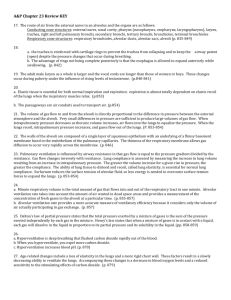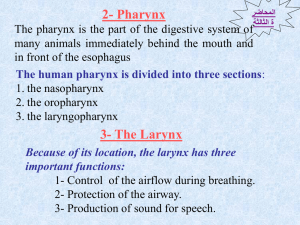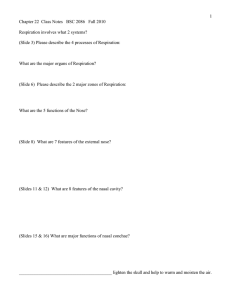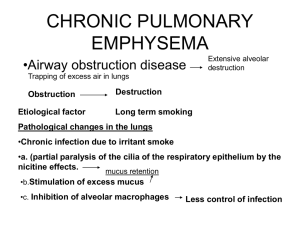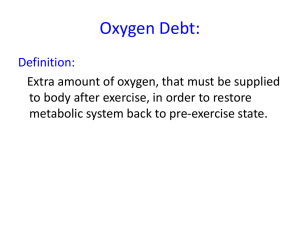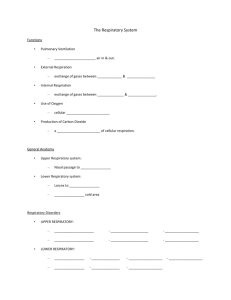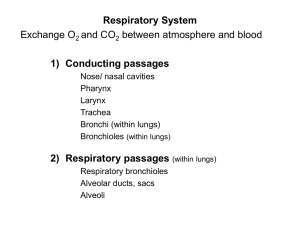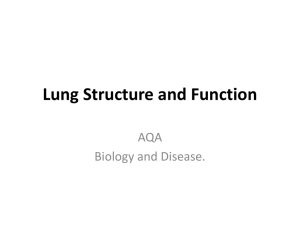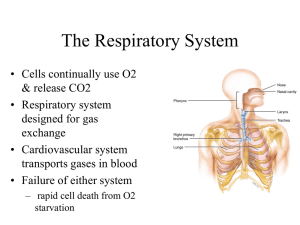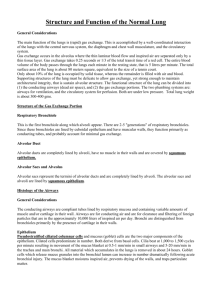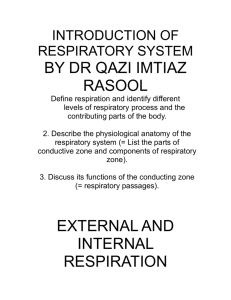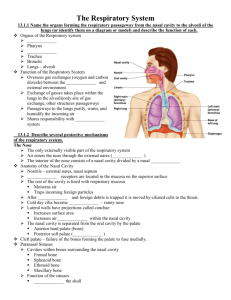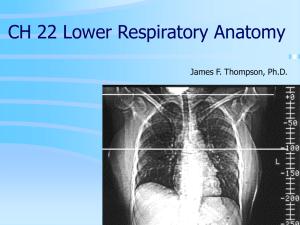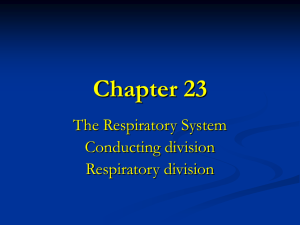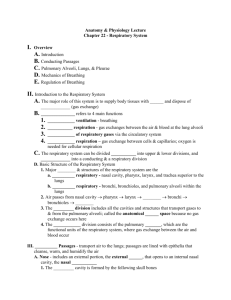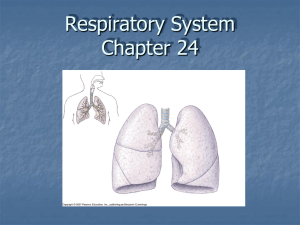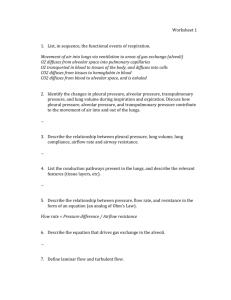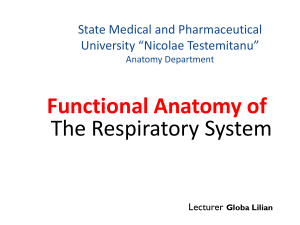File
advertisement
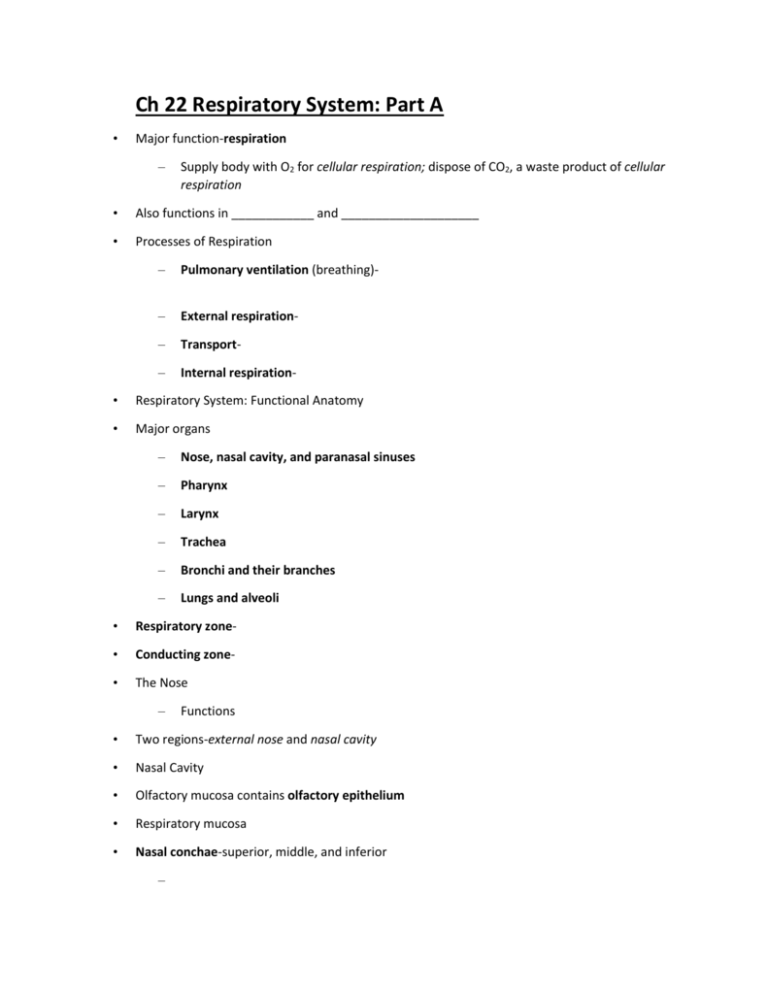
Ch 22 Respiratory System: Part A • Major function-respiration – Supply body with O2 for cellular respiration; dispose of CO2, a waste product of cellular respiration • Also functions in ____________ and ____________________ • Processes of Respiration – Pulmonary ventilation (breathing)- – External respiration- – Transport- – Internal respiration- • Respiratory System: Functional Anatomy • Major organs – Nose, nasal cavity, and paranasal sinuses – Pharynx – Larynx – Trachea – Bronchi and their branches – Lungs and alveoli • Respiratory zone- • Conducting zone- • The Nose – Functions • Two regions-external nose and nasal cavity • Nasal Cavity • Olfactory mucosa contains olfactory epithelium • Respiratory mucosa • Nasal conchae-superior, middle, and inferior – • Homeostatic Imbalance • Rhinitis – • Pharynx – • • Three regions – Nasopharynx – Oropharynx – Laryngopharynx Larynx – • Functions Nine cartilages of larynx – All hyaline cartilage except epiglottis – Thyroid cartilage with laryngeal prominence (Adam's apple) – Epiglottis-elastic cartilage; covers laryngeal inlet during swallowing; covered in taste bud-containing mucosa • Vocal ligaments- • Vestibular folds • Voice Production – – • Vocal folds may act as sphincter to prevent air passage – Example-Valsalva's maneuver – • • Trachea – Windpipe–from larynx into mediastinum – Trachealis muscle Bronchi – • Conducting Zone Structures – Trachea right and left main (primary) bronchi • • • Branches become smaller and smaller – Bronchioles-less than 1 mm in diameter – Terminal bronchioles-smallest-less than 0.5 mm diameter • From bronchi through bronchioles, structural changes occur • Respiratory Zone • Begins as terminal bronchioles respiratory bronchioles alveolar ducts alveolar sacs – Alveolar sacs contain clusters of alveoli • ~300 million alveoli make up most of lung volume • Sites of gas exchange • Respiratory Membrane • Alveolar walls • – Single layer of squamous epithelium (type I alveolar cells) – Scattered cuboidal type II alveolar cells secrete surfactant and antimicrobial proteins Alveoli – Surrounded by fine elastic fibers and pulmonary capillaries – Alveolar pores connect adjacent alveoli • – Alveolar macrophages keep alveolar surfaces sterile • • • Equalize air pressure throughout lung 2 million dead macrophages/hour carried by cilia throat swallowed Lungs – Apex- – Base- – Hilum- Left lung smaller than right • Right lung • Bronchopulmonary segments (10 right, 8–10 left) separated by connective tissue septa – If diseased can be individually removed • Blood Supply • Pulmonary circulation (low pressure, high volume) • – Pulmonary arteries – Pulmonary veins Bronchial arteries provide oxygenated blood to lung tissue • • Mechanics of Breathing • Pulmonary ventilation consists of two phases – Inspiration- – Expiration- • Homeostatic Imbalance • Atelectasis (lung collapse) due to • – Plugged bronchioles collapse of alveoli – Pneumothorax-air in pleural cavity Pulmonary Ventilation – • • Inspiration and expiration Mechanical processes that depend on volume changes in thoracic cavity – Volume changes pressure changes – Pressure changes gases flow to equalize pressure Inspiration – Active process • • Expiration – Quiet expiration normally passive process •

